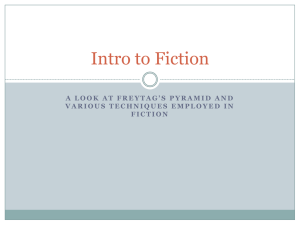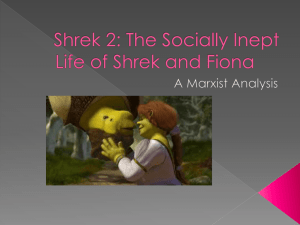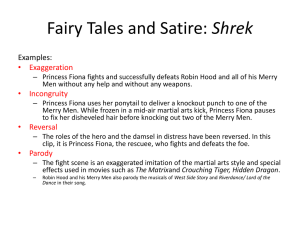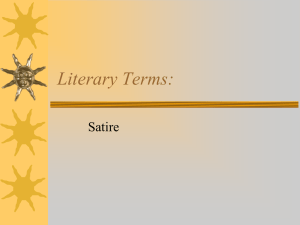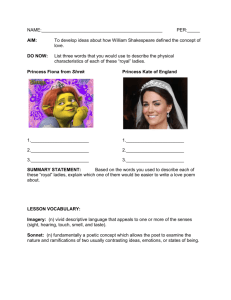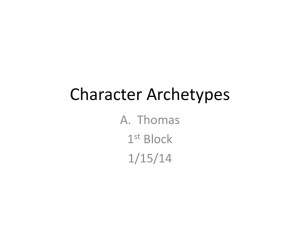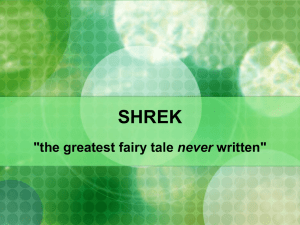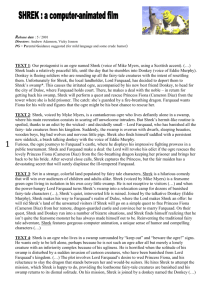File - Kaitlyn Moeslein
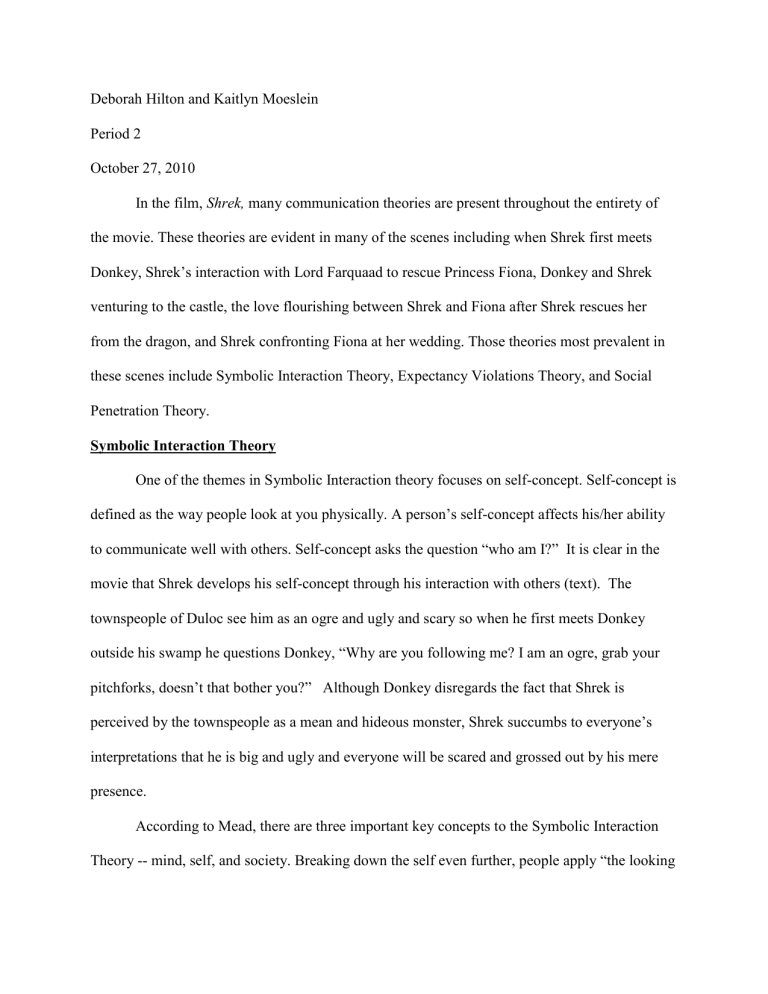
Deborah Hilton and Kaitlyn Moeslein
Period 2
October 27, 2010
In the film, Shrek, many communication theories are present throughout the entirety of the movie. These theories are evident in many of the scenes including when Shrek first meets
Donkey, Shrek’s interaction with Lord Farquaad to rescue Princess Fiona, Donkey and Shrek venturing to the castle, the love flourishing between Shrek and Fiona after Shrek rescues her from the dragon, and Shrek confronting Fiona at her wedding. Those theories most prevalent in these scenes include Symbolic Interaction Theory, Expectancy Violations Theory, and Social
Penetration Theory.
Symbolic Interaction Theory
One of the themes in Symbolic Interaction theory focuses on self-concept. Self-concept is defined as the way people look at you physically. A person’s self-concept affects his/her ability to communicate well with others. Self-concept asks the question “who am I?” It is clear in the movie that Shrek develops his self-concept through his interaction with others (text). The townspeople of Duloc see him as an ogre and ugly and scary so when he first meets Donkey outside his swamp he questions Donkey, “Why are you following me? I am an ogre, grab your pitchforks, doesn’t that bother you?” Although Donkey disregards the fact that Shrek is perceived by the townspeople as a mean and hideous monster, Shrek succumbs to everyone’s interpretations that he is big and ugly and everyone will be scared and grossed out by his mere presence.
According to Mead, there are three important key concepts to the Symbolic Interaction
Theory -- mind, self, and society. Breaking down the self even further, people apply “the looking
glass self” theory, they take on the role of the other imagining how we look to another person
(Griffin 1997). In the movie Shrek , the main character, an ogre named Shrek, is always concerned about how others perceive him physically since he is a giant green ogre. On the journey back to Lord Farquaad’s castle, Shrek overhears Princess Fiona speaking with Donkey calling herself ugly and hideous because she turns her into an ogre everyday after sunset. The morning after, Shrek is angry and tells Donkey that he overheard Princess Fiona. “She said I was ugly and hideous. I overheard the two of you talking,” Shrek exclaims. But Donkey replies,
“She wasn’t talking about you? She was talking about someone else.” Shrek, of course, doesn’t believe him because he believes everyone sees him as ugly and hideous.
Expectancy Violations Theory
Expectancy Violations Theory suggests that people hold expectations regarding the nonverbal behavior of others (text). Proxemics, the study of a person’s use of space, is a major concept of Expectancy Violations Theory. When Donkey first meets Shrek, Donkey invades
Shrek’s personal space. Shrek has a more social proxemic zone, spanning four to 12 feet while
Donkey has a more personal distance zone encompassing 18 inches to four feet. Shrek is very uncomfortable by how close Donkey is during their first encounter because Donkey stands so close to him and is right in Shrek’s face.
Another concept to the proxemic zones is territoriality, or a person’s ownership of an area or object (text). Shrek’s swamp is an example of a primary territoriality signaling his own home and where he lives and goes through his everyday rituals. Shrek tells Donkey, “I already told you, didn’t I. You’re not coming home with me! I live alone this is my swamp. Me! Nobody else understands.” Naturally, people are defensive when their territory is invaded. Near the beginning of Shrek , Lord Farquaad sends out fairytale creatures to visit Shrek’s swamp making Shrek
angry. He responds by confronting Lord Farquaad, which begins the challenge for Shrek to rescue Princess Fiona. If Shrek is successful, Lord Farquaad will give Shrek his swamp back.
Donkey does not see why the swamp means so much to Shrek. “There just me and my swamp,”
Shrek says, “And the first thing I’m going to do when I get back is build a ten-foot wall around it.” Our expectations vary from one person to another.
Another important aspect of the Expectancy Violations Theory is arousal, which means that when a person’s expectations are violated by another, their interest in each other increases.
A prime example in the movie occurs as Shrek and Princess Fiona stop to take a rest from their quest to Duloc to meet Lord Farquaad. Shrek and Princess Fiona’s relationship further develops when Shrek notices that Princess Fiona’s actions are uncharacteristic of a normal princess and are more like his own. Examples of this are when they make balloon animals out of a frog and a snake and give them to each other, when Fiona makes Shrek unusual cotton candy out of spider webs and bugs, and when they sit down for dinner and eat weed rats.
When expectations are violated, people can interpret it either positively or negatively resulting in violation valance. Therefore, communicators will interpret the meaning of a violation and decide whether they like or dislike it. Shrek and Fiona have a positive assessment toward their expectations about one another. They show throughout the movie that even though they are different people and hold different values they still like each other.
Social Penetration Theory
Social Penetration Theory exists as relationships develop and communication moves from relatively shallow no intimate levels to deeper, more personal ones (text). An assumption of this theory includes self-disclosure or sharing information with others that one would not normally know or discover thereby helping the relationship grow. At the end of the movie, Shrek
displays his true feelings to Fiona when he objects at her wedding to Lord Farquaad. “I love you.” Shrek admits. Ironically, Fiona shares her secret and opens up to Shrek about becoming an ogre after sunset. Eventually, after fighting against Lord Farquaad and his army, the couple set off together and plan to be married. Self-disclosure helped both Shrek and Princess Fiona display their true love for one another. If they had kept their true feelings in, they would have never gotten to experience true love.
To further describe the importance of self-disclosure, Altman and Taylor incorporate an analogy to an onion (text). When one peels the outer skin from an onion, another skin is uncovered. When the second layer is removed, a third is exposed, and so forth. The outer layer of an onion exposes people’s information that is available to the public eye such as height, weight, gender, etc. Below the surface layer, the information is more private like beliefs, faiths, prejudices, and general relationship information. Within the inner core, one holds their values, beliefs, self-concept, and deep emotions. The inner core is the most private information that is not revealed right away to people. However, the amount of information revealed by one can also vary depending on culture.
In the movie Shrek , Donkey and Shrek are venturing through a sunflower field on their way to rescue Princess Fiona as Shrek uses this same onion analogy. “Ogres are like onions,”
Shrek explains. Donkey doesn’t understand and says “Oh you leave ‘em out in the sun, they get all brown, start sproutin’ little white hairs,” Shrek corrects Donkey and says “No! Layers …
Onions have layers. Ogres have layers. Onions have layers. You get it? We both have layers.”
Donkey does not seem to understand the onion analogy correctly but it is obvious that Shrek is trying to explain that ogres are like onions because you have to peel away to get deeper down into their feelings instead of taking one look at an ogre and running away. Later, Princess Fiona
and Donkey would find out that Shrek really does have feelings he would like to share and does care about others. He’s not your typical ogre that scares people and really wants to become a friend and that’s a major reason why he lets Donkey in to help him rescue Fiona.
These are just a few of the many theories that can be applied to the movie Shrek . A few others are the Social Exchange Theory, which is illustrated when Fiona decides to marry Lord
Farquaad because she would rather stay beautiful and marry somebody she does not love than be with the person she loves and remain “ugly”. She feels that, in the end, the reward would be greater than the cost. Another theory plausible in Shrek is the Relational Dialectics Theory which is demonstrated when Fiona is picking petals off a flower to decide whether or not to tell
Shrek her secret. This concept is considered an openness and protection tension (text).
Communication theories are used throughout our lives; they are in the movies we watch, the television and print advertisements we read, and our verbal and nonverbal interactions with others. There is not just one theory that can be applied to any specific event. Symbolic
Interaction Theory, Expectancy Violation Theory, and Social Penetration Theory are just some of those theories utilized in the various forms of media and social interaction human beings are involved with everyday.
Bibliography
1. Griffin, E. (1997). A first look at Communication Theory. New York: The McGraw Hill
Companies.
